How to Create a Toolpath Pattern - Translate
Introduction
This tutorial explains how to create a toolpath pattern using the Translate option. The example provided shows how to create a toolpath pattern for two features separately. The first feature is patterned using coordinate values (Delta method), and the second feature is patterned by selecting geometry (Sketch/Enter method). Both methods define the distance that the pattern is translated.
Example Part
The BobCAD part file for this tutorial is available for download at: http://bobcad.com/helpfiles. If you are connected to the Internet, you can click the link provided to download and save the Toolpath Pattern Translate Example 1 BBCD.zip file. After extracting the zip file, you can open the file to follow along with this example. In the example file provided, the stock and Machine Setup are already defined for the part.
In the example file provided, the first two features, a pocket and two drill holes, are already created for the part. The toolpath patterns are added to copy the defined features to the non-machined areas of the part. In this example, you add toolpath patterns to each feature individually. This is done instead of patterning all of the features in the Machine Setup, because you may want to add other machining features that do not need to be included in the patterns.

Part 1) Pattern the First Feature
In the following steps, the distance between features is already known, so Delta values are used to define the distance that each feature is copied from the current position. For example, you can use any point of one pocket and measure the distance in X and Y to the same point of the next pocket.
-
In the CAM Tree Manager, below
 Machine Setup, right-click
Machine Setup, right-click
 Feature 2 Axis,
and click Add Toolpath Pattern.
Feature 2 Axis,
and click Add Toolpath Pattern. -
In the Toolpath Pattern dialog box, click Translate, and click Next>>.
-
With Delta selected, in the Copies box, type 2.
This creates two copies of the current feature.

-
Under Delta, in the X box, type 2.500.
This defines the distance between each feature along the X-axis of the machining coordinate system.

-
In the Y box, type 1.500.
This defines the distance between features along the Y-axis of the machining coordinate system.
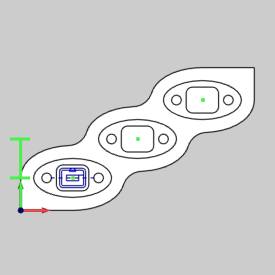
-
To compute the toolpath pattern, click OK.
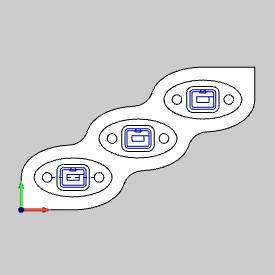
You can see that the original feature is copied twice and patterned by the specified values.
Part 2) Pattern the Hole Feature
In the following steps, instead of entering values for the distance between features, geometry is selected directly from the part model. This method is helpful when you have a part but do not know the distances to use. The start and end points that are selected create a line that is used to define the distance that each pattern copy is moved.
-
In the CAM Tree, right-click
 Feature Mill Hole, and click
Add Toolpath Pattern.
Feature Mill Hole, and click
Add Toolpath Pattern. -
In the Toolpath Pattern dialog box, click Translate, and click Next>>.
-
In the Translate group, click Sketch/Enter.
-
In the Copies box, type 2.
-
To select geometry that defines the start point, under Start, click Pick.
To show the snap points of the entity, press and hold Shift and click the surface edge as shown next.
(Be sure to click the surface edge and not the face.)
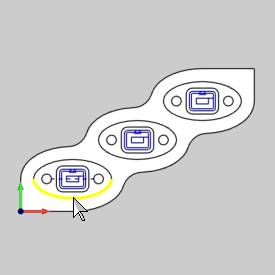
When the snap points are shown, click the point on the right as shown next.

Notice that the Start values are automatically updated. (The values are X3.5 Y1.25 Z0.)
If you do not have the same values, repeat the process and make sure that the snap point changes to the highlight color before you click it.
-
In the End group, to select geometry, click Pick.
Select the same surface edge of the middle pocket as shown next.
(Press and hold Shift while clicking the edge.)

Select the snap point on the right.
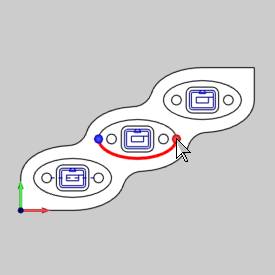
After making the selection, the End values are X6 Y2.75 Z0.
-
To calculate the toolpath pattern, click OK.
(To better view the patterned feature, the original pattern and feature are hidden in the image.)
Tip: To hide
a toolpath pattern, in the CAM Tree, right-click ![]() Toolpath
Pattern and click Blank/Unblank
Toolpath Pattern. Alternatively, if you hide the original feature,
the original feature and the pattern are hidden.
Toolpath
Pattern and click Blank/Unblank
Toolpath Pattern. Alternatively, if you hide the original feature,
the original feature and the pattern are hidden.

Part 3) Simulate the Program
-
In the quick access toolbar, of the CAM Tree Manager, click
 .
.
(Alternatively, you can right-click ![]() Milling Job,
and click Simulation.)
Milling Job,
and click Simulation.)
After simulating, the stock model appears as shown next.
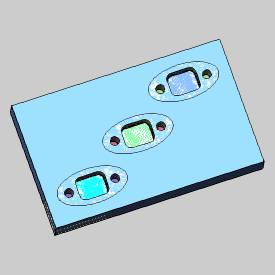
-
To close the simulation, click
 Exit Simulation.
Exit Simulation.
This concludes the tutorial.
